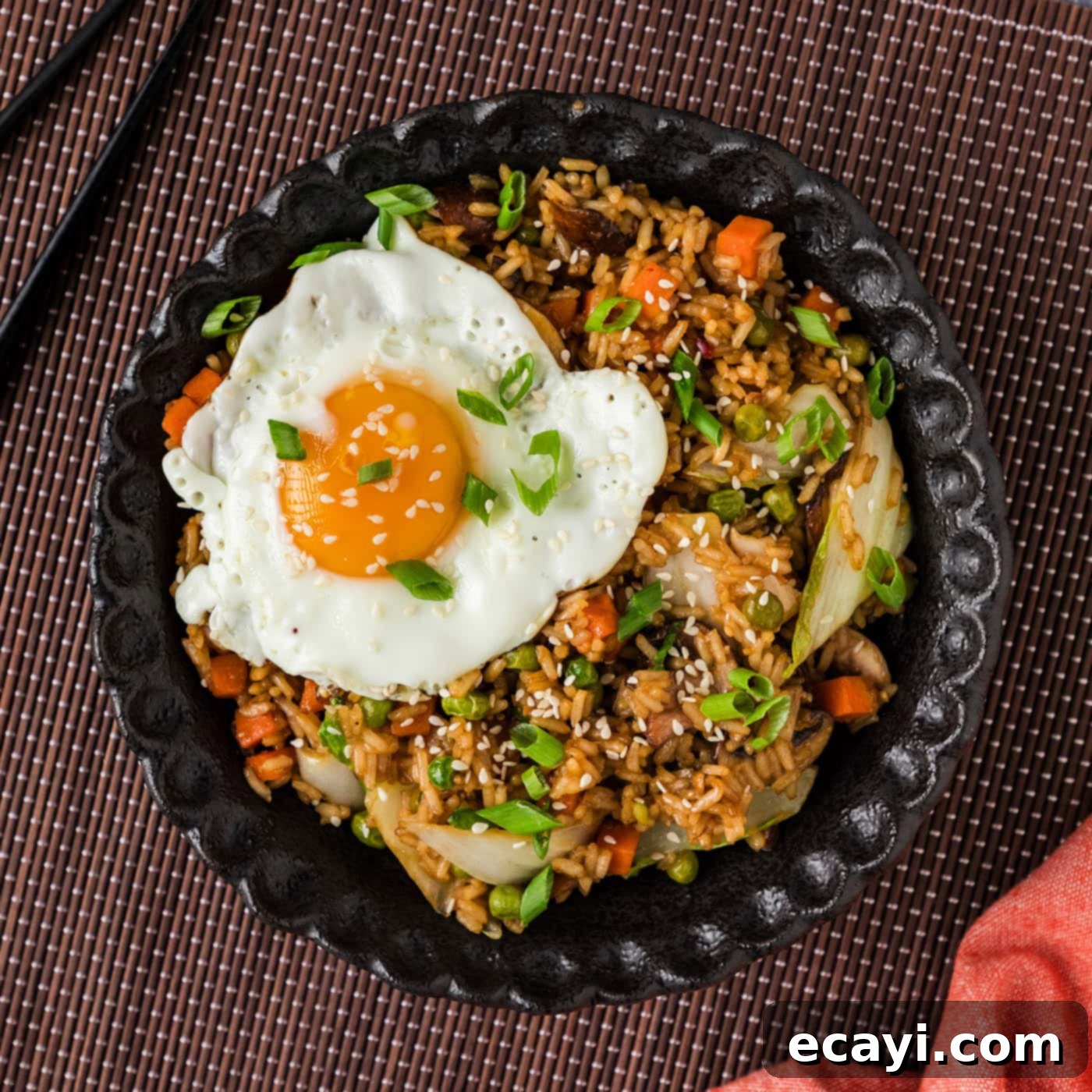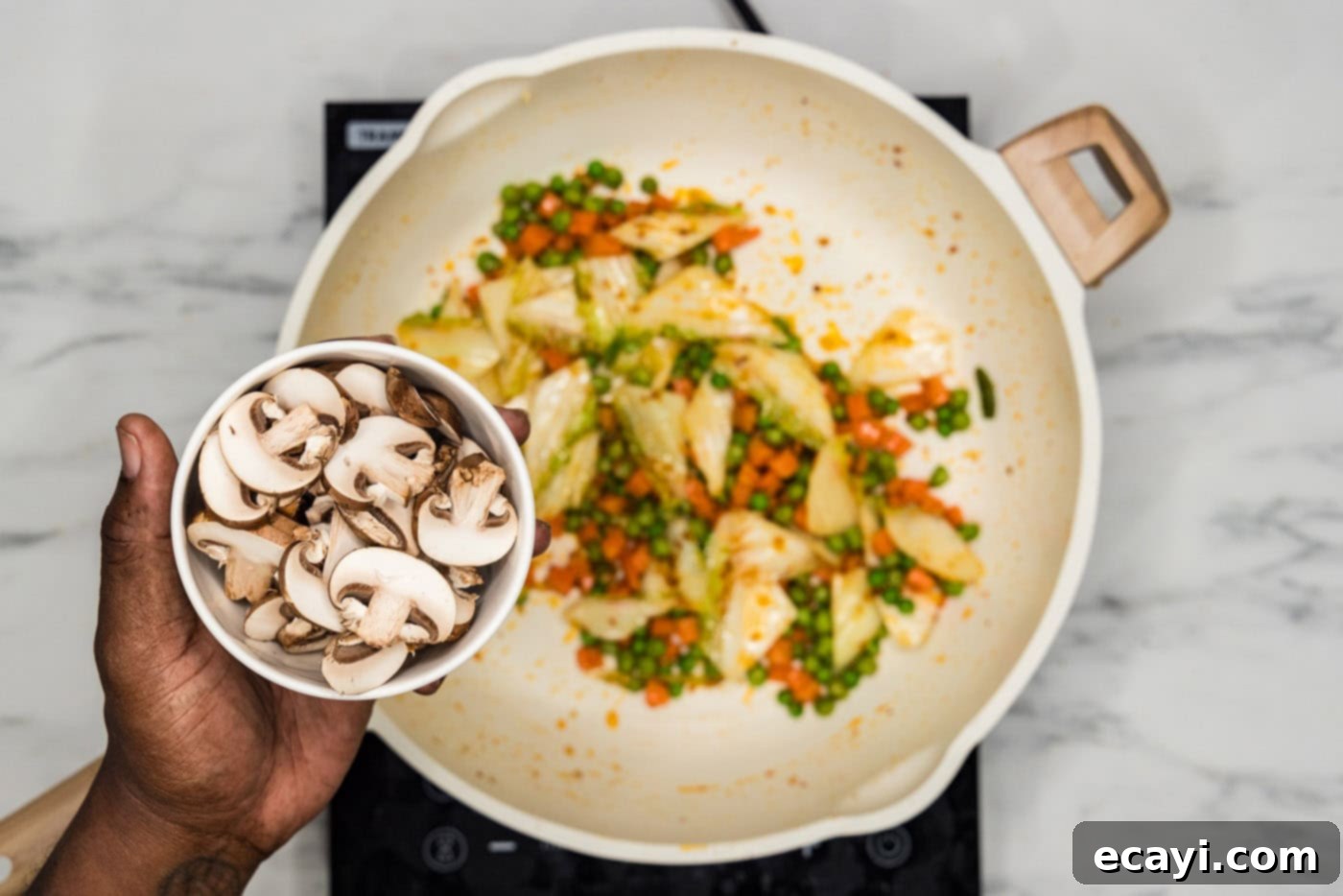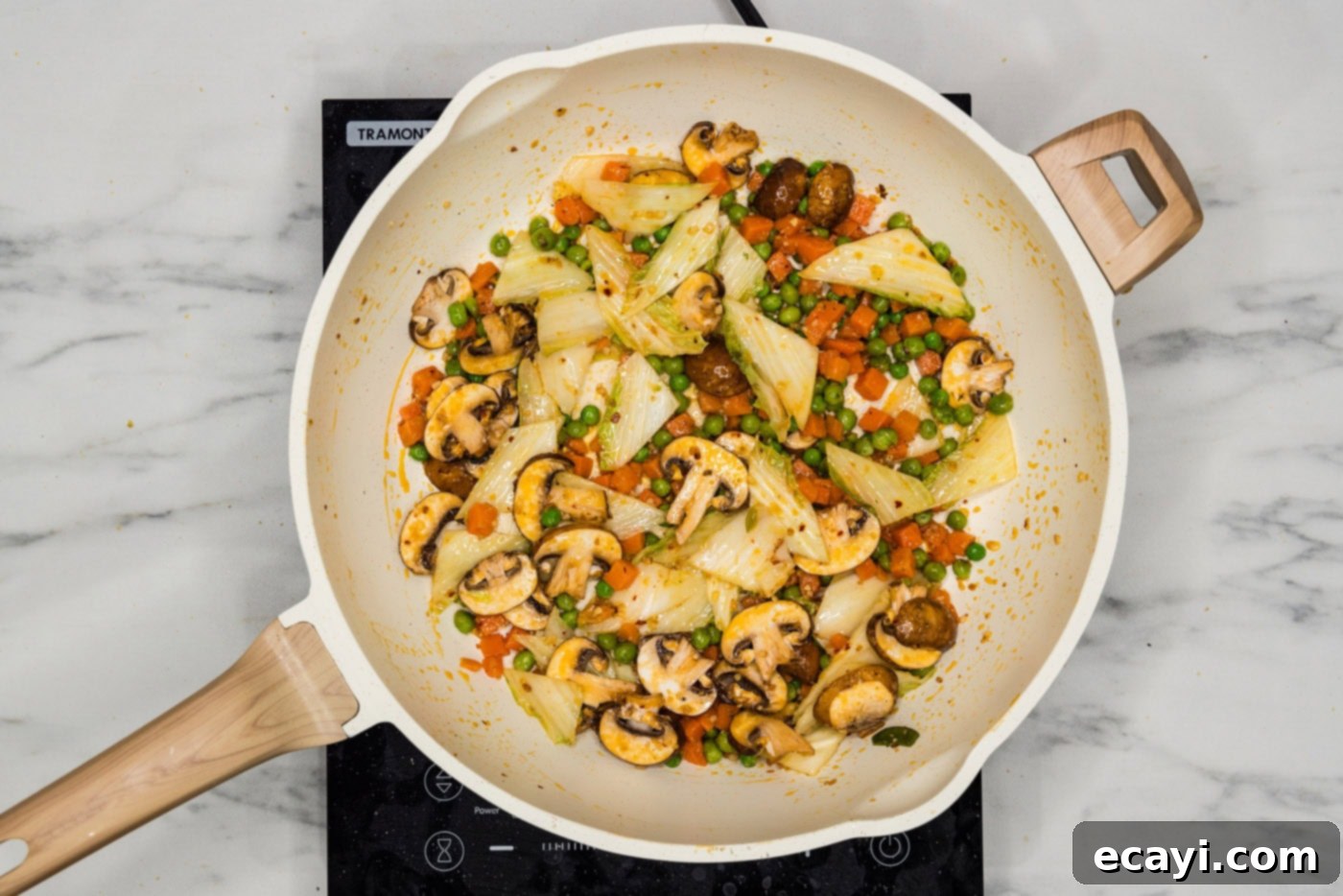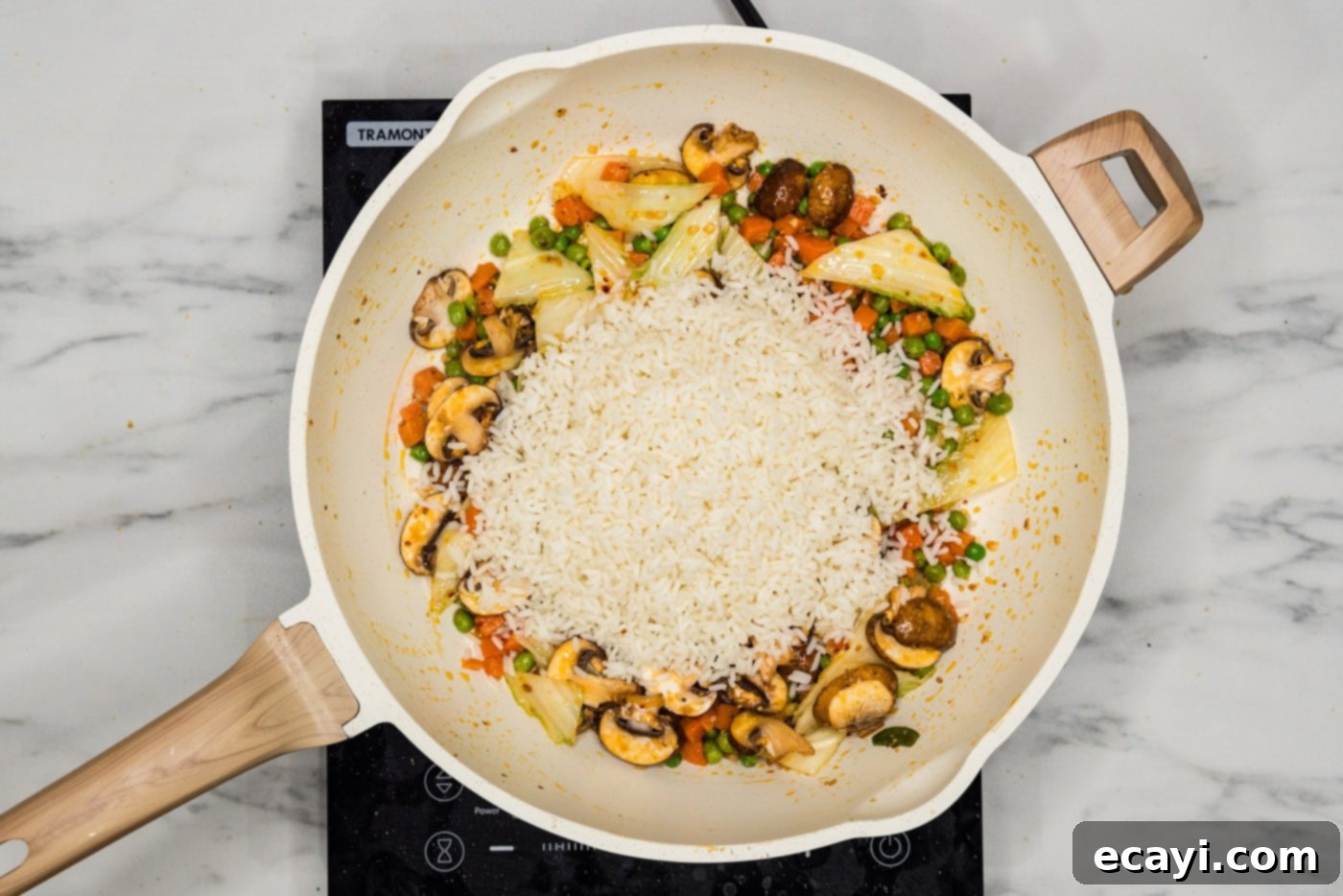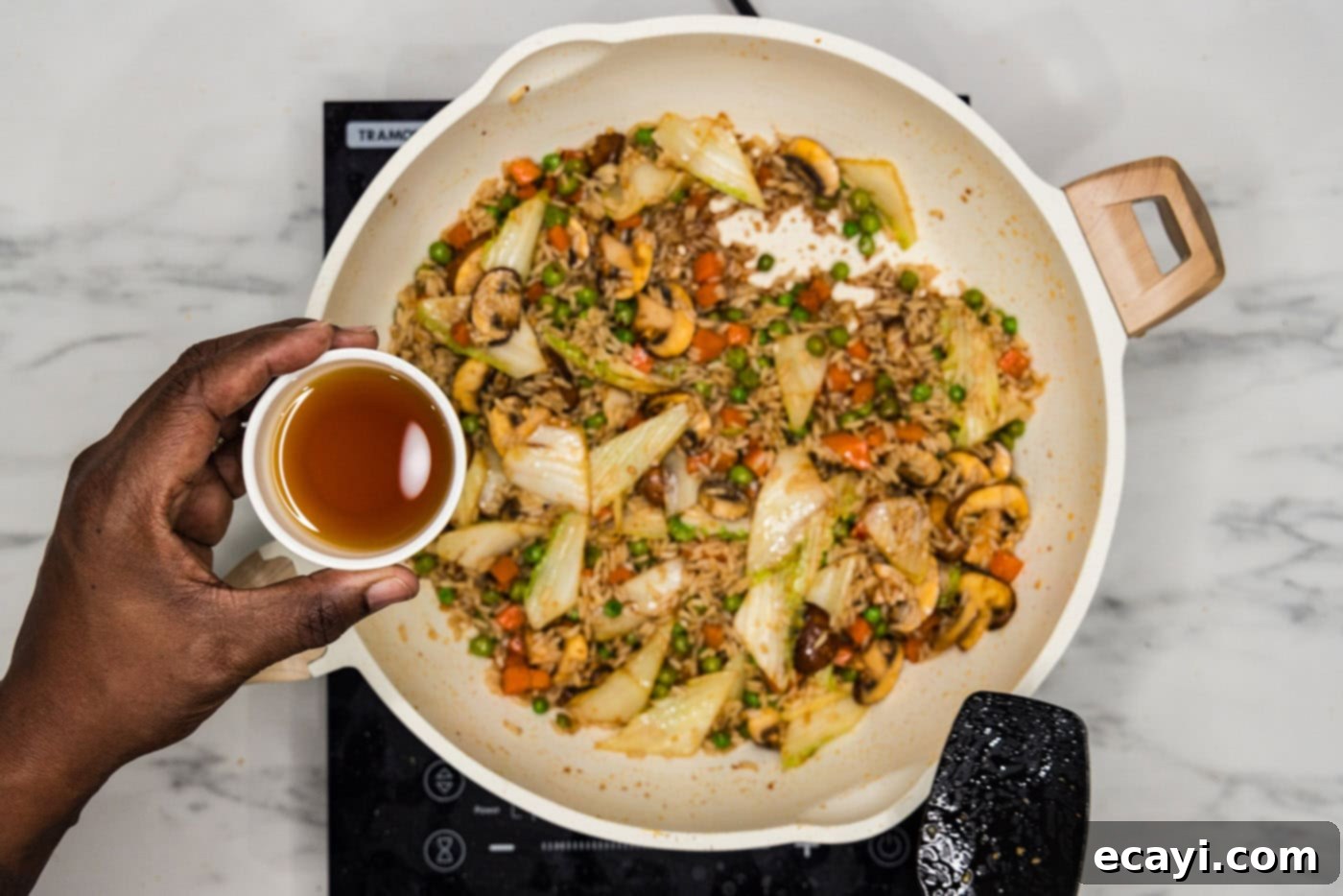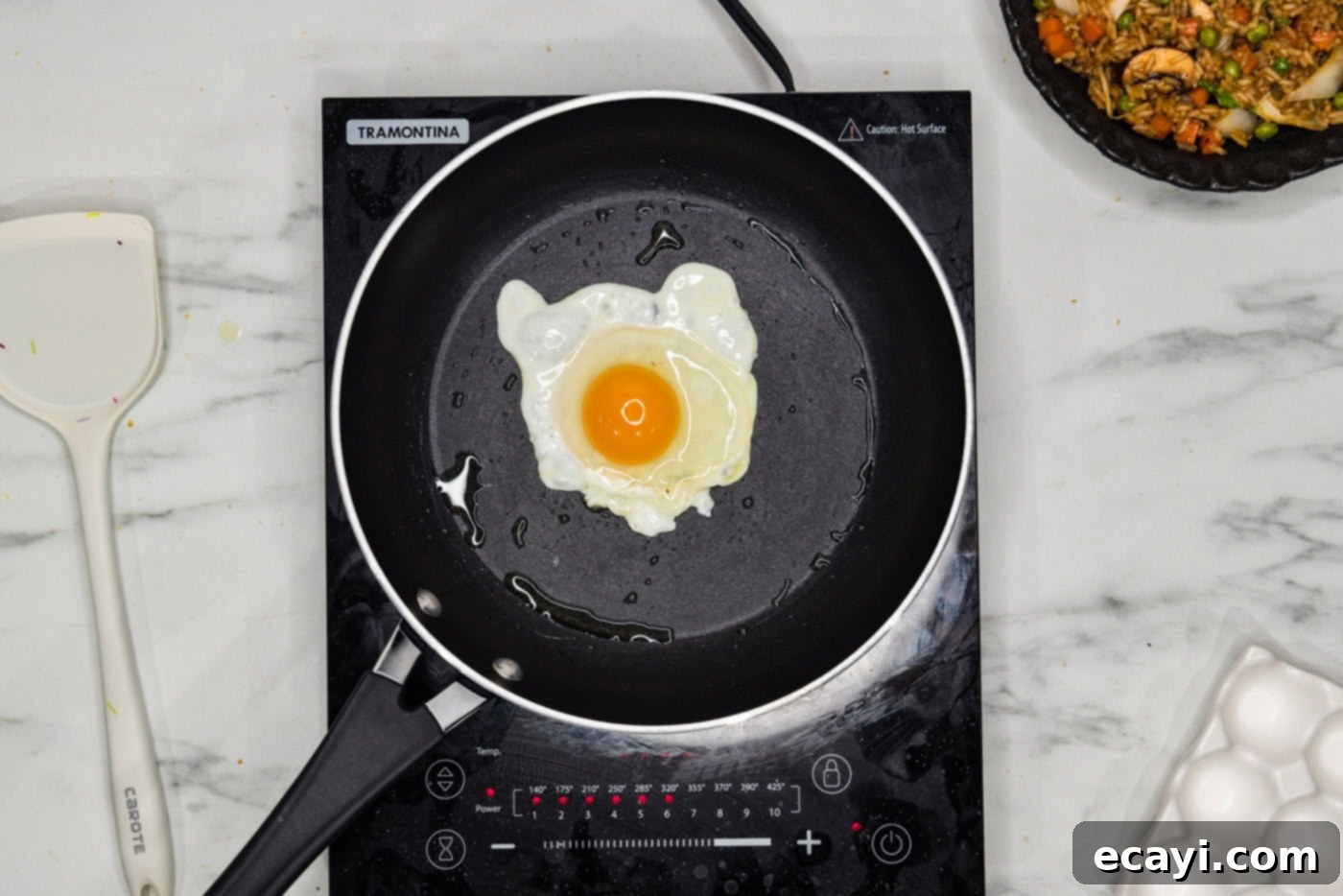Delicious & Easy Korean Fried Rice (Bokkeum-Bap) Recipe
Embark on a culinary journey to Korea with this incredibly flavorful fried rice recipe, known as Bokkeum-Bap. This dish bursts with vibrant flavors from a savory blend of garlic, hoisin, and soy sauce, perfectly stir-fried with an abundance of crisp, colorful vegetables. It’s a quick, satisfying meal that brings the essence of Korean cuisine right to your kitchen, making it an instant family favorite.
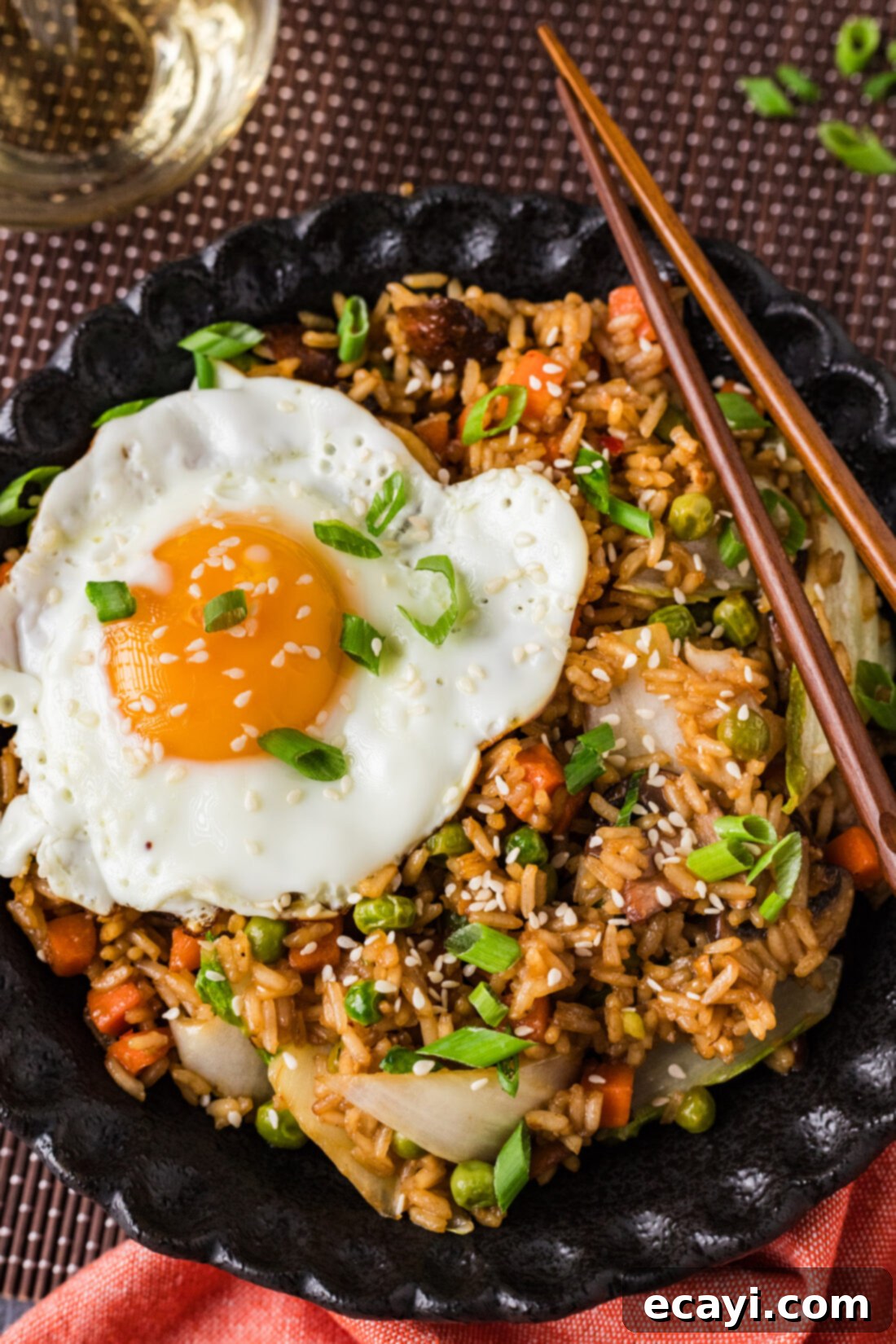
Why This Korean Fried Rice Recipe Will Be Your New Go-To
Korean fried rice, or Bokkeum-Bap (볶음밥), is much more than just a simple stir-fried rice dish. It’s a cornerstone of Korean comfort food, cherished for its versatility, deep flavors, and satisfying textures. This particular recipe stands out for several compelling reasons, promising a delicious and authentic experience.
Unlike its Chinese counterpart, which often utilizes long-grain rice, traditional Korean fried rice is predominantly made with **short-grain rice**. This is a crucial distinction that dramatically impacts the dish’s texture. Short-grain rice, sometimes referred to as sushi rice, is naturally stickier and starchier when cooked. This characteristic allows it to absorb the robust sauces and flavors much more effectively, creating a wonderfully chewy and cohesive bite, reminiscent of a luxurious risotto but with a distinctly Asian flair. If you’ve never tried fried rice with short-grain rice, prepare for a delightful textural revelation!
Beyond the rice, the flavor profile of this Bokkeum-Bap is truly exceptional. We infuse it with a powerful trio of **garlic, hoisin, and soy sauce**, creating a balance of savory, sweet, and umami notes that coat every grain. This rich sauce is then complemented by the fiery kick of **crunchy garlic chili sauce** – a common staple in Korean cooking that adds a layer of depth and excitement without overwhelming the palate. Paired with a generous medley of fresh, bright vegetables, this dish offers a harmonious blend of textures and tastes.
Furthermore, this Korean fried rice recipe is incredibly versatile and convenient. It’s perfect for transforming **leftover rice** into a gourmet meal, preventing food waste and saving you time. It’s also remarkably quick to prepare, making it an ideal choice for busy weeknights when you crave something wholesome and flavorful without spending hours in the kitchen. Whether you’re a seasoned chef or a beginner, the straightforward steps ensure success every time, delivering a restaurant-quality meal that’s both comforting and exciting.
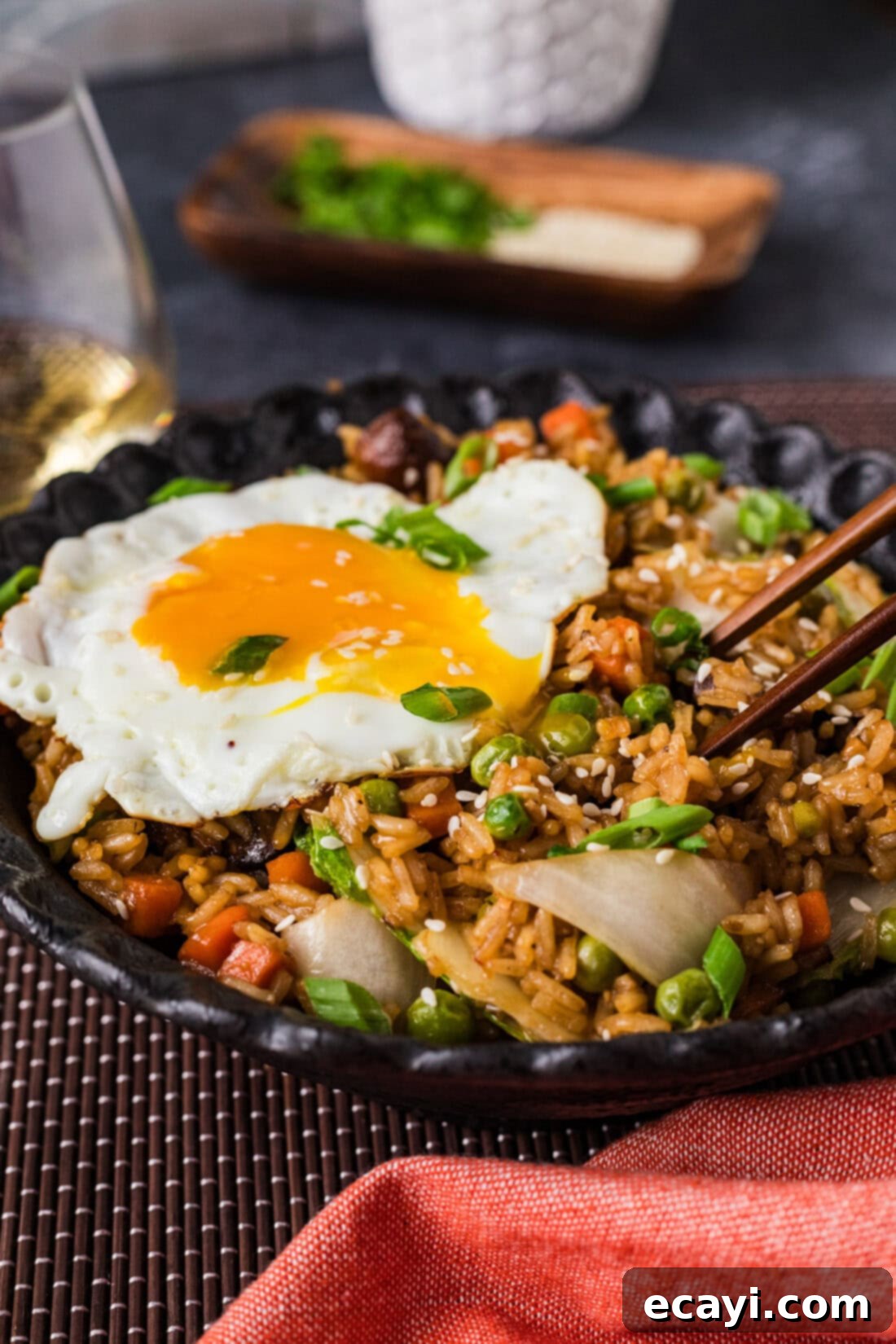
Essential Ingredients for Your Korean Fried Rice
Crafting the perfect Korean fried rice starts with a selection of fresh, high-quality ingredients that bring a symphony of flavors and textures to the dish. Gather these essentials to create a truly memorable Bokkeum-Bap. You can find all specific measurements, ingredients, and detailed instructions in the printable recipe card at the very end of this blog post.
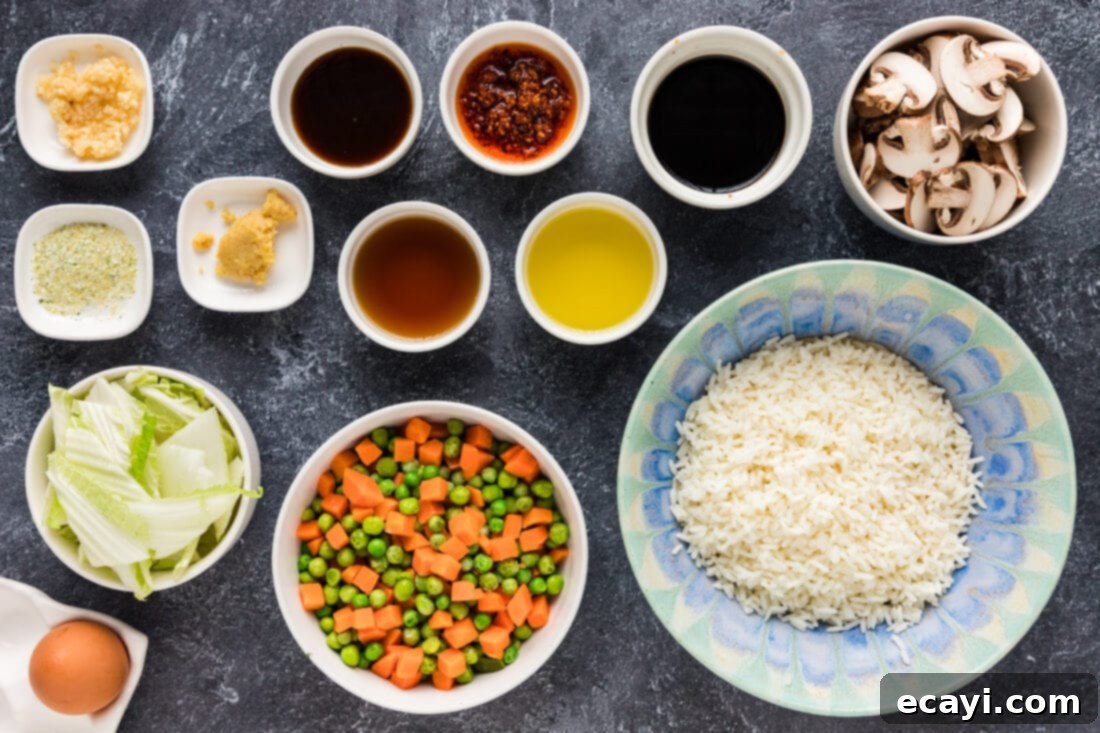
Ingredient Spotlight & Smart Substitutions
Let’s dive deeper into the key components of this Korean fried rice and explore some useful tips and alternative options to customize your meal.
RICE: The Foundation of Fried Rice
For an authentic Korean fried rice experience, **short-grain white rice** (often labeled as sushi rice) is highly recommended. Its inherent stickiness and plump texture are ideal for absorbing sauces and providing that characteristic chewy mouthfeel. However, if short-grain rice isn’t available, or if you simply prefer it, **medium-grain white rice** is an excellent substitute, offering a similar starchy quality. While long-grain rice can be used in a pinch, be aware that the texture will be less cohesive and slightly drier. The golden rule for any fried rice is to use **day-old, cooked rice**. This ensures the rice grains are firm and slightly dry, preventing sogginess and allowing them to crisp up beautifully in the wok or skillet. If you’re cooking fresh rice for this recipe, spread it out on a baking sheet and let it cool completely, or even chill it in the refrigerator for an hour, to remove excess moisture.
VEGGIES: Your Canvas for Color and Nutrition
The beauty of fried rice lies in its adaptability when it comes to vegetables. This recipe features a delightful mix of **carrots, peas, napa cabbage, and mushrooms (baby Bella or white button)**, providing a spectrum of colors, flavors, and nutrients. Feel free to get creative and incorporate your favorite vegetables or whatever you have on hand. Other popular Korean fried rice additions include:
- Kimchi: For a tangy, spicy, and fermented depth of flavor. If adding kimchi, you might slightly reduce the amount of chili sauce.
- Snow Peas or Snap Peas: For a crisp, sweet crunch.
- Spring Onions (Scallions): Both the white and green parts add a fresh, pungent bite.
- Bell Peppers: Any color works, adding sweetness and crunch.
- Zucchini or Korean Squash (Hobak): Sliced thin for a tender addition.
- Spinach or Kale: Stir-fried quickly at the end for a boost of greens.
- Bean Sprouts: For a refreshing, crisp texture.
Ensure all vegetables are uniformly chopped or sliced for even cooking.
ADDITIONS: The Heart of the Flavor Profile
The incredible depth of flavor in this Korean fried rice comes from a potent blend of aromatic and savory ingredients:
- Hoisin Sauce: A thick, fragrant, sweet, and salty sauce essential for authentic Asian stir-fries. It provides a beautiful glaze and umami richness.
- Low Sodium Soy Sauce: The backbone of savory flavor. Using low sodium allows you to control the overall saltiness better.
- Fresh Minced Garlic and Ginger: These aromatics are non-negotiable for their vibrant, pungent, and warming qualities that define many Asian dishes.
- Crunchy Garlic Chili Sauce: This popular condiment adds a fantastic texture with crispy garlic bits and a pleasant level of heat. If you’re looking for an alternative or want to amp up the traditional Korean spice, **Gochujang** (Korean chili paste) is an excellent substitute. Gochujang offers a more fermented, deeply savory, and sweet heat. Start with a smaller amount and add more to taste, as its spice level can vary.
- Sesame Oil: A finishing oil that imparts a rich, nutty aroma and flavor, typically added at the very end of cooking.
- Garlic Salt: Enhances the garlic notes and provides overall seasoning.
For an extra layer of umami, consider adding a dash of **fish sauce** or **oyster sauce** (if not making it vegetarian). You can also incorporate protein like thinly sliced beef, chicken, shrimp, or tofu for a more substantial meal. Add these proteins after the aromatics and cook until almost done before adding vegetables.
Step-by-Step: Crafting Your Korean Fried Rice
These step-by-step photos and detailed instructions are here to guide you visually through the process of making this delightful Korean fried rice. For a quick reference, you can Jump to Recipe to access the printable version of this recipe, complete with precise measurements and instructions at the bottom of the page.
- Prepare Your Skillet: Heat 2 Tablespoons of olive oil in a large skillet or wok over medium-high heat until it shimmers. A hot pan is key for stir-frying to achieve that desired slightly crispy texture on your ingredients.
- Sauté the Aromatics and Cabbage: Add 1 Tablespoon of minced garlic, 2 teaspoons of minced ginger, and 1 cup of chopped napa cabbage to the hot skillet. Stir-fry for 1-2 minutes until the aromatics are fragrant and the cabbage begins to soften. Be careful not to burn the garlic.
- Add Remaining Vegetables: Introduce 1 Tablespoon of crunchy garlic chili sauce (or Gochujang for more authentic Korean spice), 1 ½ cups of frozen carrots and peas, 1 ½ teaspoons of garlic salt, and 8 ounces of sliced mushrooms (baby Bella or white button). Continue to sauté for 3-4 minutes, stirring frequently, until the mushrooms start to become tender and release their moisture. The vegetables should still retain a slight crispness.


- Incorporate Rice and Sauces: Add 2 cups of cooked short-grain rice (preferably day-old and cold) to the skillet. Drizzle in 2 Tablespoons of hoisin sauce, ¼ cup of low sodium soy sauce, and 2 Tablespoons of sesame oil. Use your spatula to break up any clumps of rice and stir everything together thoroughly, ensuring the rice and vegetables are evenly coated with the flavorful sauce. Continue to cook, stirring occasionally, for about 2-3 minutes, until the fried rice is heated through and some of the rice grains develop a slightly crispy texture.


- Cook the Egg (Optional but Recommended!): Once the fried rice is ready, transfer it to a serving bowl. In the same skillet, add a touch more oil if needed and cook 1 large egg to a sunny-side-up style. The runny yolk will add a creamy richness to the fried rice. Gently slide the cooked egg on top of your Korean fried rice.

Frequently Asked Questions & Expert Tips for Perfect Korean Fried Rice
Store any leftover Korean fried rice in an airtight container and refrigerate it promptly. It will stay fresh and delicious for up to 3 days. When reheating, use a microwave and add a small splash of water or a teaspoon of sesame oil to help moisten the rice and restore its texture. Alternatively, reheat in a skillet over medium heat until warmed through.
Yes, absolutely! Frozen cooked rice works wonderfully for fried rice. Simply thaw it in the microwave or at room temperature, then fluff it with a fork before adding it to the skillet. Ensure it’s not overly wet. Using frozen (and thawed) rice can often mimic the dry texture of day-old refrigerated rice, which is ideal.
A large wok or a heavy-bottomed skillet (like cast iron or stainless steel) is ideal for making fried rice. The high heat and ample surface area allow the ingredients to stir-fry effectively without steaming. Make sure your pan is large enough so you don’t overcrowd it, which can lead to soggy results.
This recipe is easily adaptable for vegetarian diets by omitting the egg or using a plant-based egg substitute. For a fully vegan version, ensure your hoisin sauce is vegan (some brands contain oyster extract), and of course, omit the egg. You can add extra vegetables, tofu, or tempeh for added protein and substance.
The spice comes primarily from the crunchy garlic chili sauce or Gochujang. To make it milder, reduce the amount of chili sauce or omit it entirely. For more heat, add an extra teaspoon or two, or incorporate a pinch of Korean chili flakes (gochugaru) along with your vegetables.
Expert Tips for the Best Korean Fried Rice:
- Use Day-Old or Chilled Rice: This is perhaps the most important tip. Cold, dry rice grains separate easily and crisp up without becoming mushy.
- High Heat is Your Friend: Cook your fried rice over medium-high to high heat. This ensures proper stir-frying, giving the vegetables a slight char and the rice a pleasant crispness.
- Don’t Overcrowd the Pan: Cook in batches if necessary, especially if you’re doubling the recipe. Overcrowding lowers the pan’s temperature and steams the ingredients instead of frying them.
- Prep All Ingredients First: Stir-frying is a rapid process. Have all your vegetables chopped, sauces measured, and rice ready before you even turn on the stove. This is called “mise en place.”
- Taste and Adjust: Always taste your fried rice before serving. You might want to add a little more soy sauce for saltiness, a dash of sugar for sweetness, or extra chili sauce for heat.
- Garnish for Freshness: Fresh garnishes like sliced green onions and a drizzle of sesame oil not only add visual appeal but also a burst of fresh flavor.
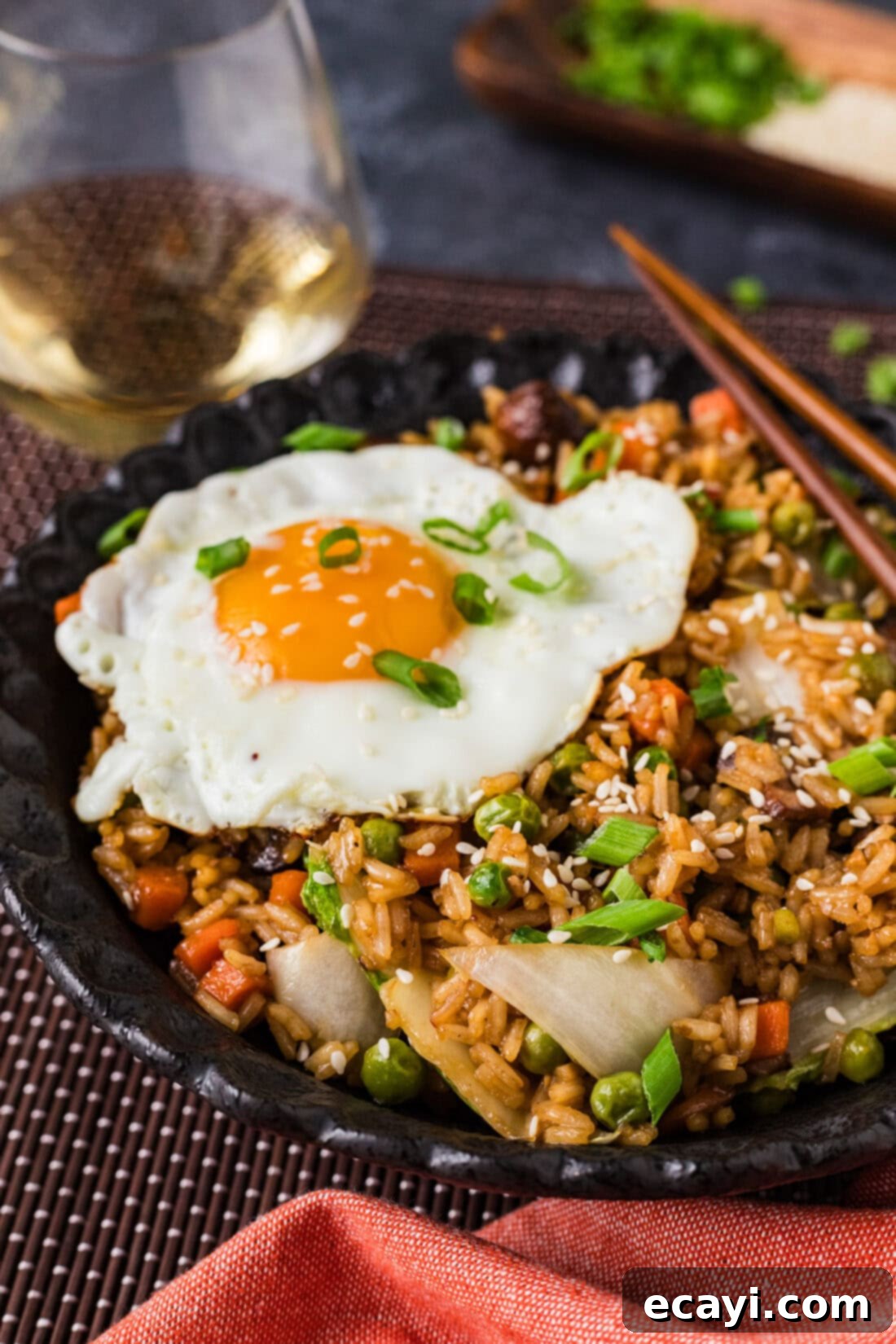
Perfect Pairings & Serving Suggestions
Korean fried rice, especially with a perfectly cooked sunny-side-up egg on top, is substantial enough to be a hearty lunch or a satisfying main course on its own. However, for a more elaborate meal, it also pairs wonderfully with a variety of Korean side dishes (banchan) or other Korean-inspired entrees.
To elevate your Bokkeum-Bap, consider these garnishes and serving ideas:
- Fresh Spring Onions: Finely sliced spring onions add a fresh, pungent crunch and beautiful green color.
- Toasted Sesame Seeds: A sprinkle of toasted sesame seeds adds a nutty flavor and appealing texture.
- Drizzle of Sesame Oil: A final drizzle of toasted sesame oil just before serving enhances the nutty aroma.
- Seaweed Flakes (Gim/Nori): Crumbled roasted seaweed sheets provide a salty, umami crunch.
- Kimchi: Serve a small bowl of fresh kimchi on the side for an extra layer of fermented spice and tang.
If you’re looking to create a full Korean feast, consider serving this fried rice alongside any of the delightful recipes listed below for dinner:
Explore More Korean-Inspired Delights
If you’ve enjoyed the flavors of this Korean Fried Rice, you’re in for a treat! Korean cuisine offers a world of bold, exciting tastes and textures. Don’t stop here – dive into these other fantastic Korean-inspired recipes that are sure to become new favorites in your home.
- Savory Beef Bulgogi
- Tender Korean Short Ribs (Galbi)
- Quick Korean Fish Cakes (Eomuk Bokkeum)
- Crispy Korean Fried Chicken
I love to bake and cook and share my kitchen experience with all of you! Remembering to come back each day can be tough, that’s why I offer a convenient newsletter every time a new recipe posts. Simply subscribe and start receiving your free daily recipes!
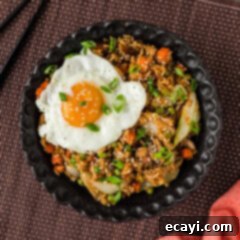
Korean Fried Rice (Bokkeum-Bap)
IMPORTANT – There are often Frequently Asked Questions within the blog post that you may find helpful. Simply scroll back up to read them!
Print It
Pin It
Rate It
Pin It
Save ItSaved!
Ingredients
- 2 Tablespoons olive oil
- 1 Tablespoon minced garlic
- 2 teaspoons minced ginger
- 1 cup chopped napa cabbage
- 1 Tablespoon crunchy garlic chili sauce
- 1 ½ cups frozen carrots and peas
- 1 ½ teaspoons garlic salt
- 8 ounces mushrooms baby Bella or white button, sliced
- 2 cups cooked white short grain rice
- 2 Tablespoons hoisin sauce
- ¼ cup low sodium soy sauce
- 2 Tablespoons sesame oil
- 1 large egg
Equipment You’ll Need
-
Wok or a large, heavy-bottomed skillet
Before You Begin
- For the best texture, use day-old, cooked short-grain rice (also known as sushi rice). If cooking fresh rice, spread it out and let it cool completely to remove excess moisture. Long-grain rice can be used, but the texture will be less sticky.
- Feel free to customize your vegetables! Popular Korean additions include kimchi, snow peas, sliced bell peppers, zucchini, or bean sprouts.
- The recipe uses crunchy garlic chili sauce for a spicy kick. For a more traditional Korean spice and deeper fermented flavor, you can substitute it with Gochujang (Korean chili paste). Start with a small amount and adjust to your preferred spice level.
- Consider adding your favorite protein! Thinly sliced chicken, beef, shrimp, or tofu can be stir-fried before the vegetables.
Instructions
-
Heat 2 Tablespoons of olive oil in a large skillet or wok over medium-high heat until it begins to shimmer.
-
Add 1 Tablespoon of minced garlic, 2 teaspoons of minced ginger, and 1 cup of chopped napa cabbage. Sauté for 1-2 minutes until fragrant and the cabbage starts to soften.
-
Stir in 1 Tablespoon of crunchy garlic chili sauce (or Gochujang), 1 ½ cups of frozen carrots and peas, 1 ½ teaspoons of garlic salt, and 8 ounces of sliced mushrooms. Continue to sauté for 3-4 minutes, until the mushrooms are tender.
-
Add the 2 cups of cooked rice to the skillet along with 2 Tablespoons of hoisin sauce, ¼ cup of low sodium soy sauce, and 2 Tablespoons of sesame oil. Stir well to combine, breaking up any rice clumps, and cook for 2-3 minutes until heated through and well coated.
-
Remove the fried rice from the skillet and transfer to serving bowls. In the same skillet, cook 1 large egg to a sunny-side-up style. Slide the egg directly on top of each serving of fried rice. Serve immediately.
Expert Tips & FAQs
- Store any leftovers in an airtight container in the refrigerator for up to 3 days. Reheat in the microwave or a skillet, adding a splash of water or sesame oil to restore moisture if needed.
- Always use day-old or thoroughly chilled rice for the best non-soggy fried rice texture.
- Ensure your skillet or wok is very hot for effective stir-frying and a slight crisp on the rice and vegetables.
- Don’t overcrowd your pan; cook in batches if necessary to maintain high heat.
- Adjust the amount of crunchy garlic chili sauce or Gochujang to your personal spice preference.
Nutrition Information
The recipes on this blog are tested with a conventional gas oven and gas stovetop. It’s important to note that some ovens, especially as they age, can cook and bake inconsistently. Using an inexpensive oven thermometer can assure you that your oven is truly heating to the proper temperature. If you use a toaster oven or countertop oven, please keep in mind that they may not distribute heat the same as a conventional full sized oven and you may need to adjust your cooking/baking times. In the case of recipes made with a pressure cooker, air fryer, slow cooker, or other appliance, a link to the appliances we use is listed within each respective recipe. For baking recipes where measurements are given by weight, please note that results may not be the same if cups are used instead, and we can’t guarantee success with that method.
